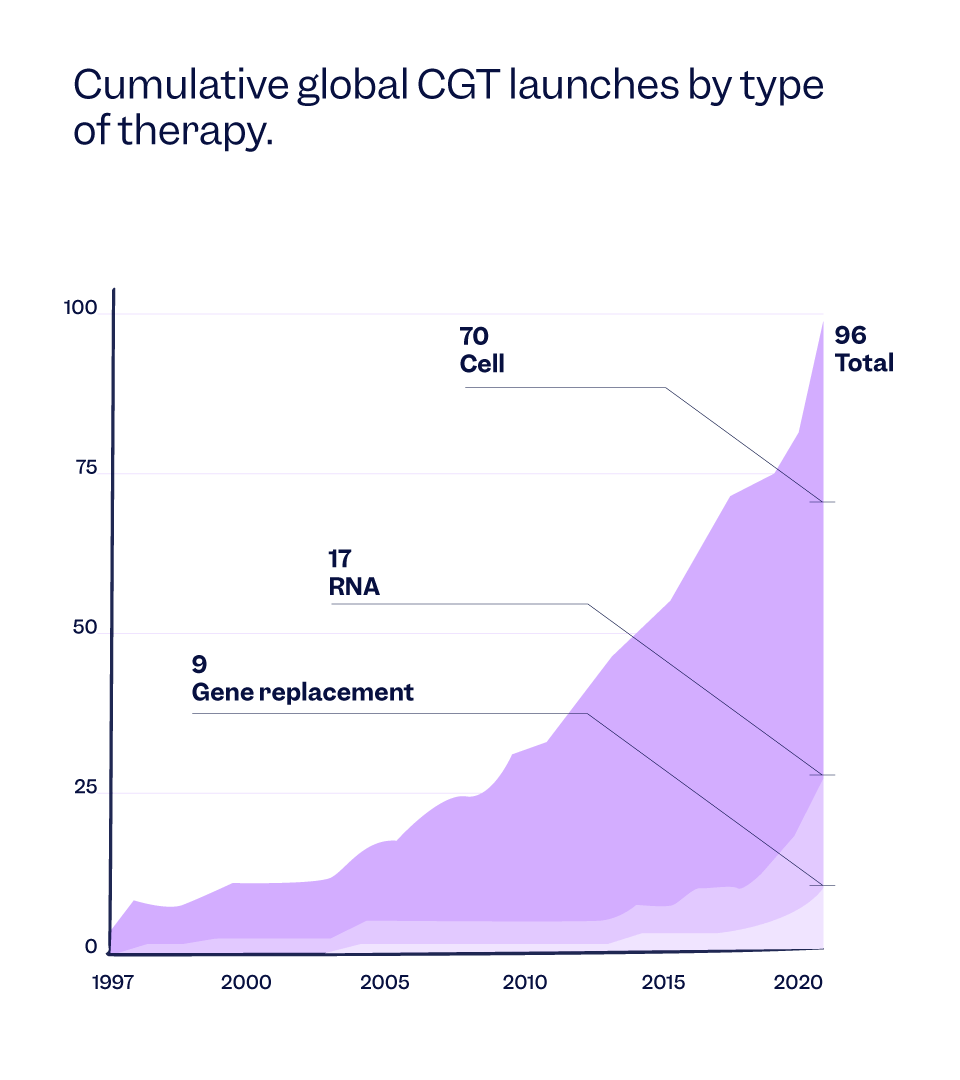EMEA Office
Louizalaan 489
1050 Brussels
Belgium

The healthcare industry is undergoing a transformation, with a shift towards personalized and targeted therapies.
For instance, the field of cell and gene therapy also known as CGT is at the forefront of the future therapies revolution. According to a report from McKinsey & Company, these therapies have the potential to cure diseases at the genetic level, offering hope to patients with previously incurable diseases or conditions.
The use of cell and gene therapies has skyrocketed since the 2010s. Different fields, such as ophthalmology, hematology, neurology, and oncology, can be potential patients of CGT.
A better understanding of the human body has also helped to accelerate the advancement of cell and gene therapies.


Advances in cell and gene therapies are transforming how we treat and potentially cure certain diseases and dramatically changing healthcare outcomes.
Targeted immunotherapies harness the body's immune system to target specific diseases. These future therapy methods are also gaining prominence in recent years by showing remarkable success in treating certain cancers and autoimmune disorders, marking a significant shift from conventional treatments.
Furthermore, recent developments in biomarker research are making it possible to identify individuals who are likely to benefit most from specific therapies based on their own biomarkers. The goal of this personalized approach is to minimize the risks of adverse effects and to maximize the effectiveness of the treatment.

Tailored therapies promise to provide more effective treatment with fewer side effects, which will result in better patient outcomes and satisfaction. This approach can also extend beyond treatment to personalized prevention strategies.
The development of novel therapies serves as a catalyst for research, innovation, and overall industry growth. As new therapeutic approaches emerge, they stimulate scientific advancements and contribute to the expansion of treatment options.
By targeting treatments more precisely, future therapies can potentially reduce the overall burden of health care costs. This targeted precision not only enhances the cost-effectiveness of healthcare delivery but also optimizes resource utilization.
To overcome the challenges associated with future therapies, the healthcare ecosystem must undergo significant changes to become fully effective with multiple stakeholders involved in this process. Key strategies for overcoming these challenges include the establishment of a consensus on standard outcomes for tracking, the implementation of real-time, long-term outcome monitoring, and the development of seamless mechanisms to trace individual patients across diverse provider systems and different payers as patients switch insurances or move across borders.
To achieve success, future therapies also require substantial investments in post-launch data collection initiatives. This includes the establishment of patient registries, conducting confirmatory trials, and innovative utilization of real-world data for continuous monitoring of safety and efficacy over extended periods. Additionally, there is a critical need for further validation of surrogate endpoints, aiming to enhance the efficiency and effectiveness of clinical trials.
Addressing the economic disruptions faced by providers and hospitals involves recognizing the transformative impact of personalized therapies on healthcare economics. When patients are cured, the demand curve shifts away from traditional pharma because they are no longer part of an addressable market. Once a percentage of these patients are treated and cured by the first-to-market therapy, that leaves a smaller population of untreated patients for those companies whose therapies are not first-to-market.
Navigating the challenges in the manufacturing sector of personalized therapies involves strategic initiatives and advancements. Investments in automation play a pivotal role in diminishing manual labor, reducing variability, and managing the cost of goods. Additionally, there is a focus on enhancing vectors and cell technology to increase throughput and the purity of active particles. The optimization of delivery systems is another critical aspect, aiming to broaden the spectrum of diseases that can be targeted, extending beyond those primarily affecting blood, liver, spine, and eyes.
When it comes to the customer journey, the expected challenge is likely to expand beyond rare disease and finding eligible patients. Some therapies are available at a limited number of facilities, so it requires patients to travel for diagnosis, treatment, and follow-up. The possible solution would be to create gene therapy centers at a limited number of sites. This would allow doctors to see more patients per year, control quality, better manage risk, and ensure patients receive a better experience overall. These centers can be chosen so that the economic incentives align with gene therapies.


As we reflect on the future of therapies, it is evident that we are on the cusp of a healthcare revolution. Could lifelong conditions, such as Parkinson’s disease, be cured through a single injection of a next-generation viral-vector gene therapy? What does the next decade look like for this life-changing field of science in bringing transformative solutions, health, and continued hope to patients?
It is clear that the future of therapies is moving towards precision, personalization, and effectiveness. The journey may be filled with challenges, but the potential benefits for patients and the healthcare industry are undeniable. Collaborations between researchers, clinicians, and technology experts will be key to realizing the full potential of personalized therapies and improving the lives of countless patients.
Furthermore, the upcoming years will be more critical to prove the sustainability of CGT as a broadly applicable therapeutic modalities. For oncology alone, more than 500 assets based on complex modalities are currently in preclinical and clinical development, and could get to market by 2030. AI and advanced analytics are likely to become vital enablers for boosting the return on R&D by increasing speed, reducing clinical failures, cutting costs across the R&D value chain, and enabling sustainable technology platforms.
Explore what lies at the forefront of innovation and quality in life sciences.
EMEA Office
Louizalaan 489
1050 Brussels
Belgium
US Office
Scilife Inc.
228 E 45th St. RM 9E
New York, NY 10017
PRODUCT
INDUSTRIES
RESOURCES
COMPANY
Contact Us
EMEA Office
Louizalaan 489
1050 Brussels
Belgium
US Office
Scilife Inc.
228 E 45th St. RM 9E
New York, NY 10017
Copyright 2025 Scilife N.V. All rights reserved.